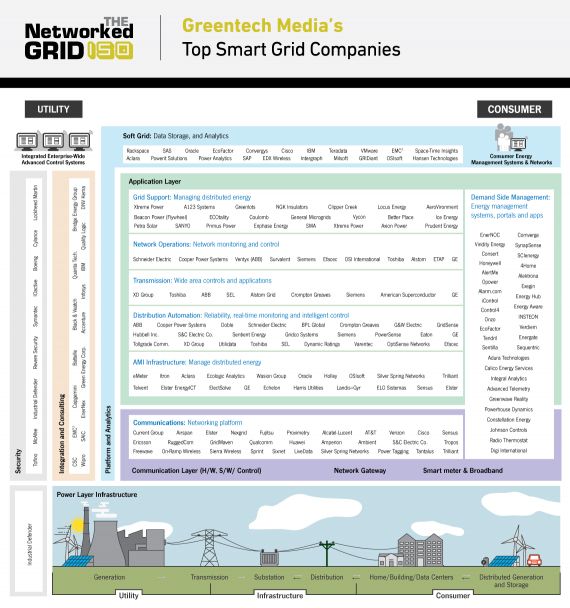At Greentech Media, we get a lot of questions asking us, who exactly is included in the The Networked Grid Top 150 Smart Grid Vendors, and why?
Every year, GTM Research takes an in-depth look at the end-to-end smart grid vendor landscape and profiles and ranks the top 150 smart grid companies across twelve key smart grid market segments. Choosing our top vendors involves assessing companies across three primary domains: smart grid solution, market dominance and growth, and sustainability.
This year, over 80 percent of the profiled vendors have had major profile changes from 2012 and we feature entirely new sets of companies that were not included in the previous edition, indicative of the recent rapid smart grid market developments. Indeed, this point is also emphasized by the ever-increasing volume of international vendors included in the report from countries such as China, Brazil, India and Japan.
FIGURE: Smart Grid Vendor Taxonomy -- Who Are the TNG 150?

Note: Click image above to see larger version
Source: The Networked Grid 150
In terms of selecting vendors, it is difficult to apply a consistent lens to an often-fragmented smart grid marketplace. However, GTM Research has identified several major markets of smart grid technologies, services and products that sit across existing, new and modernized elements of the energy value chain. When mapping vendors to the smart grid market segments defined by GTM, we started by layering the physical, infrastructural and application components of a smart grid on top of the existing power infrastructure layer. These layers can be grouped into five broad segments:
- Communications
- Smart grid applications, grid support and demand side management
- Soft grid and data analytics
- Security
- Smart grid integration and consulting
Each segment contains a number of submarkets, including advanced metering infrastructure (AMI), building area networks (BAN), consulting and integration, demand response, electric vehicle (EV) infrastructure, energy storage, field area networks (FAN), home area networks (HAN), networking and management, security, transmission & distribution (T&D), and wide area network (WAN) communications.
There are some common emerging themes across the markets, including the fact that many of the larger conglomerates covered operate in multiple markets, due to vertical and horizontal integration of their business models across the energy value chain. The report also highlights the increasing collaboration across market segments and M&A and investment activity in some of the emerging markets. In addition, we look at each segment of the value chain and assess the relative maturity of that marketplace by examining exploratory and early investing markets to more optimized and mature segments. One point is clear, however: the TNG 150 is a rapidly evolving ecosystem and the next twelve months will create new opportunities for existing and new vendors in a dynamic smart grid marketplace.
To learn more about The Networked Grid 150: The End-to-End Smart Grid Vendor Ecosystem Report and Rankings 2013 and see a full list of profiled vendors, please visit: http://www.greentechmedia.com/research/report/the-networked-grid-150-report-and-rankings-2013



